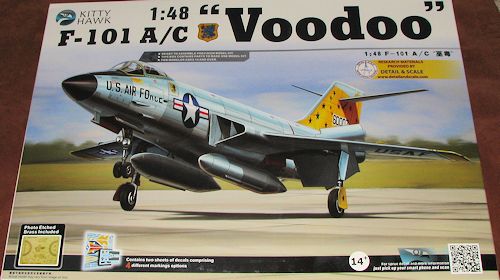
Kitty Hawk 1/48 F-101A/C Voodoo
| KIT #: | KH80115 |
| PRICE: | $85.00 SRP |
| DECALS: | Four options |
| REVIEWER: | Scott Van Aken |
| NOTES: | New Tool Kit |

| HISTORY |
The McDonnell F-101 Voodoo was a supersonic jet fighter which served the United States Air Force (USAF) and the Royal Canadian Air Force (RCAF). Initially designed by McDonnell Aircraft as a long-range bomber escort (known as a penetration fighter) for the Strategic Air Command (SAC), the Voodoo was instead developed as a nuclear-armed fighter-bomber for the Tactical Air Command (TAC), and as a photo reconnaissance aircraft based on the same airframe. Extensively modified versions were produced as an all-weather interceptor aircraft, serving with the Air Defense Command, later renamed the Aerospace Defense Command (ADC), the Air National Guard, the Royal Canadian Air Force and the unified Canadian Forces after 1968.
Despite SAC's loss of interest, the aircraft attracted the attention of Tactical Air Command (TAC), and the F-101 was reconfigured as a fighter bomber, intended to carry a single nuclear weapon for use against tactical targets such as airfields. With the support of TAC, testing was resumed, with Category II flight tests beginning in early 1955. A number of problems were identified during development, with many of these fixed. The aircraft had a dangerous tendency toward severe pitch-up at high angle of attack that was never entirely solved. Around 2,300 improvements were made to the aircraft in 1955–56 before full production was resumed in November 1956.
The first F-101A was delivered on 2 May 1957 to the 27th Strategic Fighter Wing, which transferred to TAC in July that year, replacing their F-84F Thunderstreak. The F-101A was powered by two Pratt & Whitney J57-P-13 turbojets, allowing good acceleration, climb-performance, ease in penetrating the sound barrier in level flight, and a maximum performance of Mach 1.52. The F-101's large internal fuel capacity allowed a range of approximately 3,000 mi (4,828 km) nonstop. The aircraft was fitted with an MA-7 fire-control radar for both air-to-air and air-to-ground use, augmented by a Low Altitude Bombing System (LABS) system for delivering nuclear weapons, and was designed to carry a Mk 28 nuclear bomb. The original intended payload for the F-101A was the McDonnell Model 96 store, a large fuel/weapons pod similar in concept to that of the Convair B-58 Hustler, but was cancelled in March 1956 before the F-101 entered service. Other operational nuclear payloads included the Mk 7, Mk 43, and Mk 57 weapons. While theoretically capable of carrying conventional bombs, rockets, or Falcon air-to-air missiles, the Voodoo never used such weapons operationally. It was fitted with four 20mm M39 cannon, with one cannon often removed in service to make room for a TACAN beacon-receiver.
The F-101 set a number of speed records, including: a JF-101A (the ninth F-101A modified as a testbed for the more powerful J-57-P-53 engines of the F-101B) setting a world speed record of 1,207.6 mph (1,943.4 km/h) on 12 December 1957 during "Operation Firewall", beating the previous record of 1,132 mph (1,811 km/h) set by the Fairey Delta 2 in March the previous year. The record was then subsequently taken in May 1958 by a Lockheed F-104 Starfighter. On 27 November 1957, during "Operation Sun Run," an RF-101C set the Los Angeles-New York-Los Angeles record in 6 hours 46 minutes, the New York to Los Angeles record in 3 hours, 36 minutes, and the Los Angeles to New York record in 3 hours 7 minutes.
A total of 77 F-101As were built. They were gradually withdrawn from service starting in 1966. Twenty-nine survivors were converted to RF-101G specifications with a modified nose, housing reconnaissance cameras in place of cannons and radar. These served with the Air National Guard through 1972. Two F-101As were converted as prototypes for the RF-101A. The F-101A serial sequence is 53-2418 to 2446, 54-0149-0150(YRF-101As), and 54-1438 to 1485. The only active duty unit to use the F-101A was the 81st TFW aside from a few delivered to SAC's 27th SFW.
The F-101C was basically identical to the F-101A but was heavier as the airframe was upgraded to be able to handle the design 'g' loads. Serials for the F-101C were in the 56-XXXX series. Both F-101A and F-101C aircraft were used interchangeably in the 81st TFW with the earlier planes having a warning placard in them concerning the g limit.
| THE KIT |
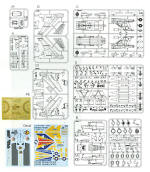 Many modelers have wanted a 1/48 F-101A and the only way to get one before now has been to purchase a conversion set for the Monogram F-101B kit. Now you do not have to as Kitty Hawk has come to the rescue of Century Series fans with this new kit.
Many modelers have wanted a 1/48 F-101A and the only way to get one before now has been to purchase a conversion set for the Monogram F-101B kit. Now you do not have to as Kitty Hawk has come to the rescue of Century Series fans with this new kit.
If you have ever built a Kitty Hawk jet kit, you know that the detailing on the aircraft is first rate. Crisply done panel lines and indented screw head detail is the norm. The kit has the rear fuselage split horizontally and a separate forward section split vertically. This is undoubtedly done to allow other single seat and two seat variants to be kitted in the future. This is obvious by looking at the way the nose section is broken down as well as the parts not used on the sprues such as camera windows as well as Genie and Falcon missiles.
The cockpit has a nicely done bang seat with etched metal harne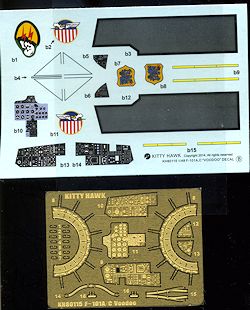 ss. Etched metal is also used for the side consoles and the main instrument panels. Once the tub is built up, it fits atop the nose gear well. KH has you install the landing gear when you build the gear well up. I'm not a fan of having landing gear protruding out to where it can be easily damaged as the kit is handled for continued building. I would suggest test fitting bits to see if the gear legs can be added after painting. Same goes for the main gear.
ss. Etched metal is also used for the side consoles and the main instrument panels. Once the tub is built up, it fits atop the nose gear well. KH has you install the landing gear when you build the gear well up. I'm not a fan of having landing gear protruding out to where it can be easily damaged as the kit is handled for continued building. I would suggest test fitting bits to see if the gear legs can be added after painting. Same goes for the main gear.
The kit has a nicely done radar antenna which you could leave as is or cover with the radome. The nose mounted retractable refueling probe is a nice option, though there seems to be no 'closed' option provided, requiring the builder to do some preparatory planning if one wants this are to be closed off. The kit also comes with full intakes and compressor faces. Same goes for the exhaust that starts at the faces and goes back to the multi piece burner cans. Some of the photo etch is used to add detail to the burner cans.
Separate ailerons and flaps are provided so that you can pose the flaps lowered. There are a myriad of small 'stand offs' that go behind the intake splitter plate. These will be difficult to install as there are no indentations or other clues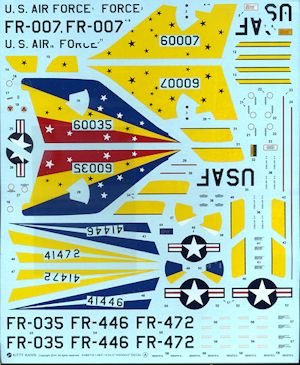 s to where they fit on the splitter itself. One just has to apparently fold each small piece and space it evenly. I would suggest replacing these with small pieces of sprue as it will make attaching them a great deal easier. As with many jet kits, the separate ailerons and rudder are designed to be installed in the neutral position. For stores, there are two large drop tanks. The canopy can be displayed open if one wishes to show off interior work.
s to where they fit on the splitter itself. One just has to apparently fold each small piece and space it evenly. I would suggest replacing these with small pieces of sprue as it will make attaching them a great deal easier. As with many jet kits, the separate ailerons and rudder are designed to be installed in the neutral position. For stores, there are two large drop tanks. The canopy can be displayed open if one wishes to show off interior work.
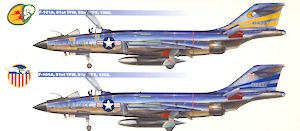 Instructions are well done with full color covers. The color info is by generic name and FS 595 reference where applicable. Decals are superbly printed and quite colorful. You get one very large sheet with most of the markings on it and a smaller one with badges and some other bits. All markings options are for the 81st TFW. The box art plane and the multi-color tail markings are for F-101Cs in 1962 while the other two options with the wedge shaped markings are for F-101As in 1960. All aircraft are unpainted metal with green drab anti glare panels and black radomes. Though not used, the painting guide even includes the missiles.
Instructions are well done with full color covers. The color info is by generic name and FS 595 reference where applicable. Decals are superbly printed and quite colorful. You get one very large sheet with most of the markings on it and a smaller one with badges and some other bits. All markings options are for the 81st TFW. The box art plane and the multi-color tail markings are for F-101Cs in 1962 while the other two options with the wedge shaped markings are for F-101As in 1960. All aircraft are unpainted metal with green drab anti glare panels and black radomes. Though not used, the painting guide even includes the missiles.
| CONCLUSIONS |
Very nice to see this one being done. I am sure that Voodoo and Century Series fans are going to be quite pleased with this one, especially as it seems the whole series will eventually be kitted.
| REFERENCES |
http://en.wikipedia.org/wiki/F-101_Voodoo
May 2014
Thanks to Kitty Hawk Models for the review kit. Get yours at your local hobby shop or on-line retailer.
If you would like your product reviewed fairly and fairly quickly, please contactthe editor or see other details in the